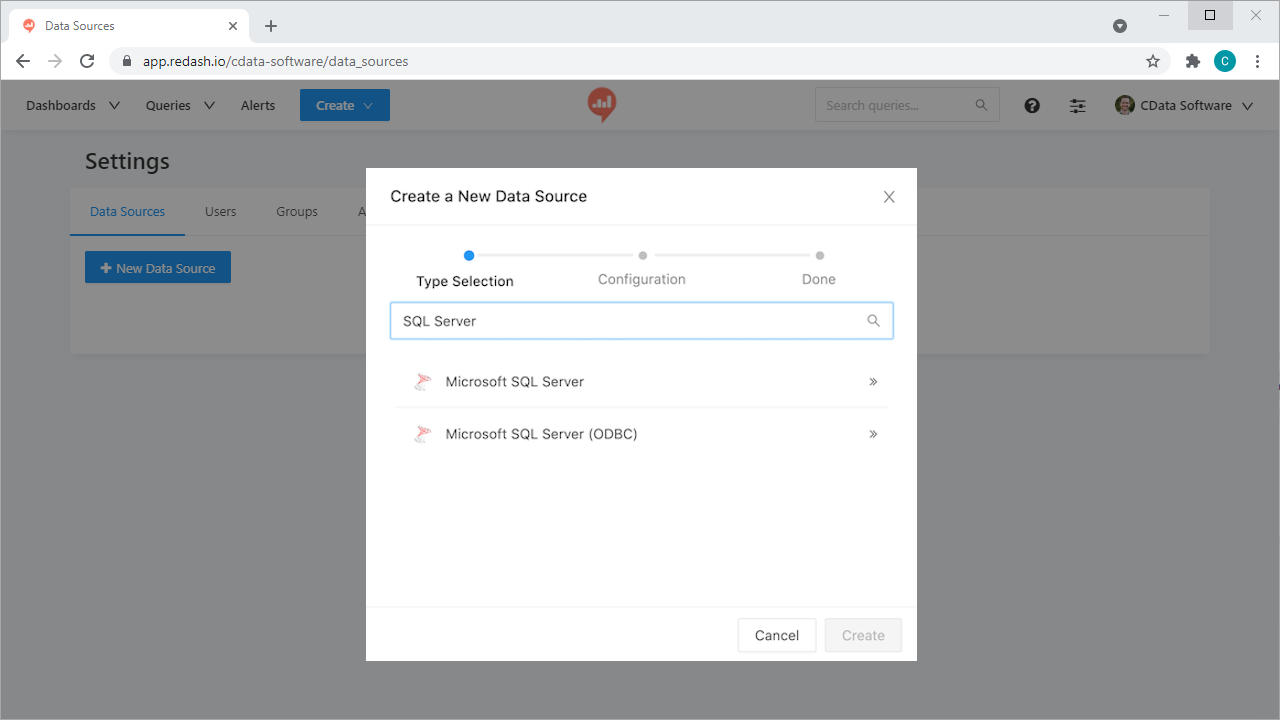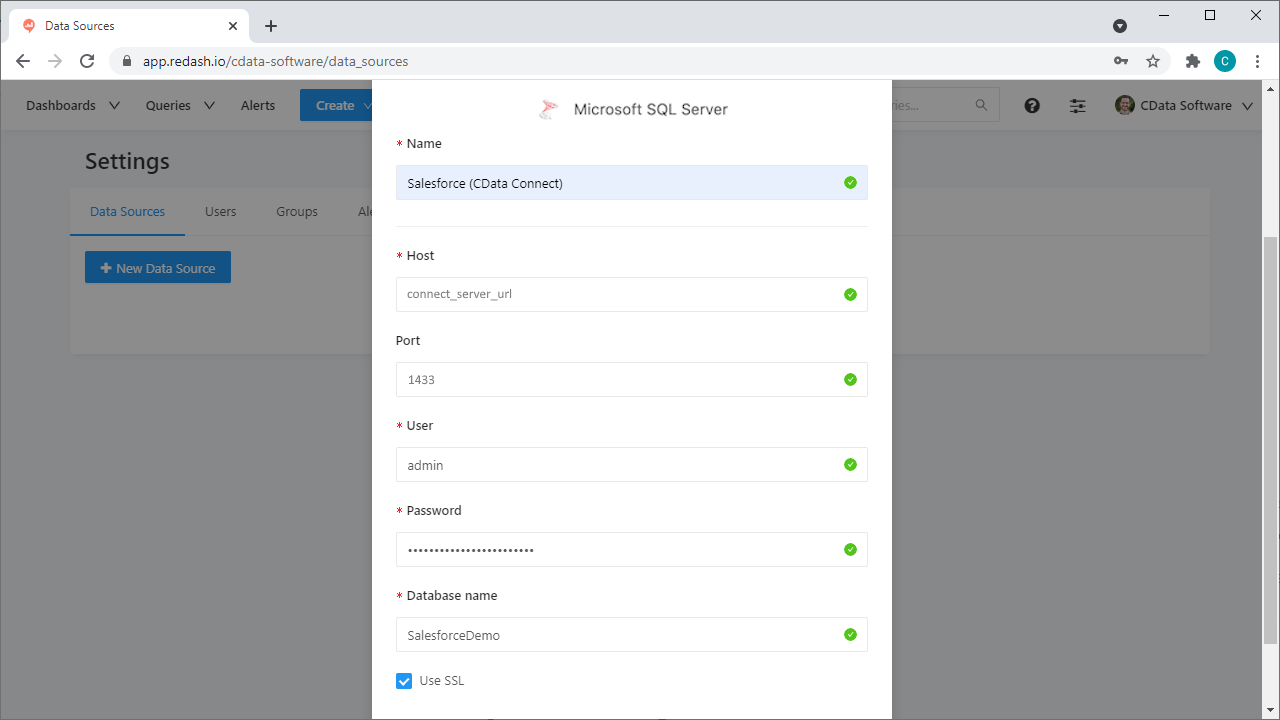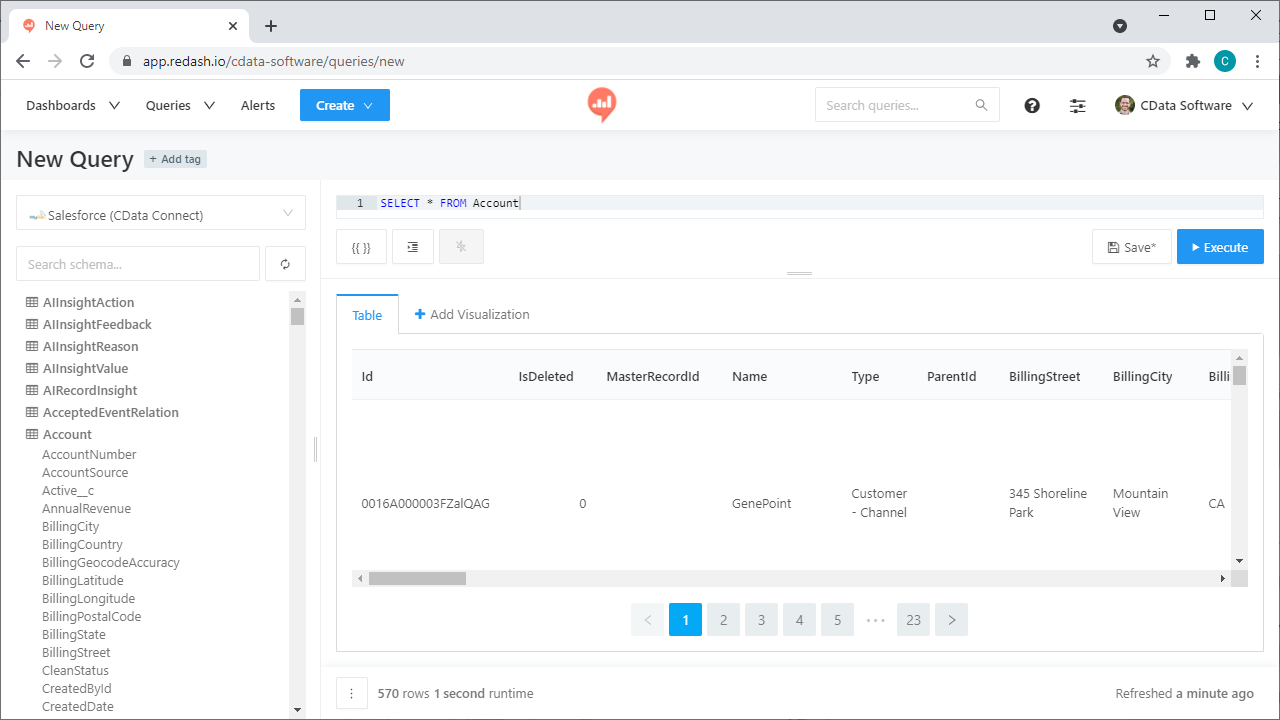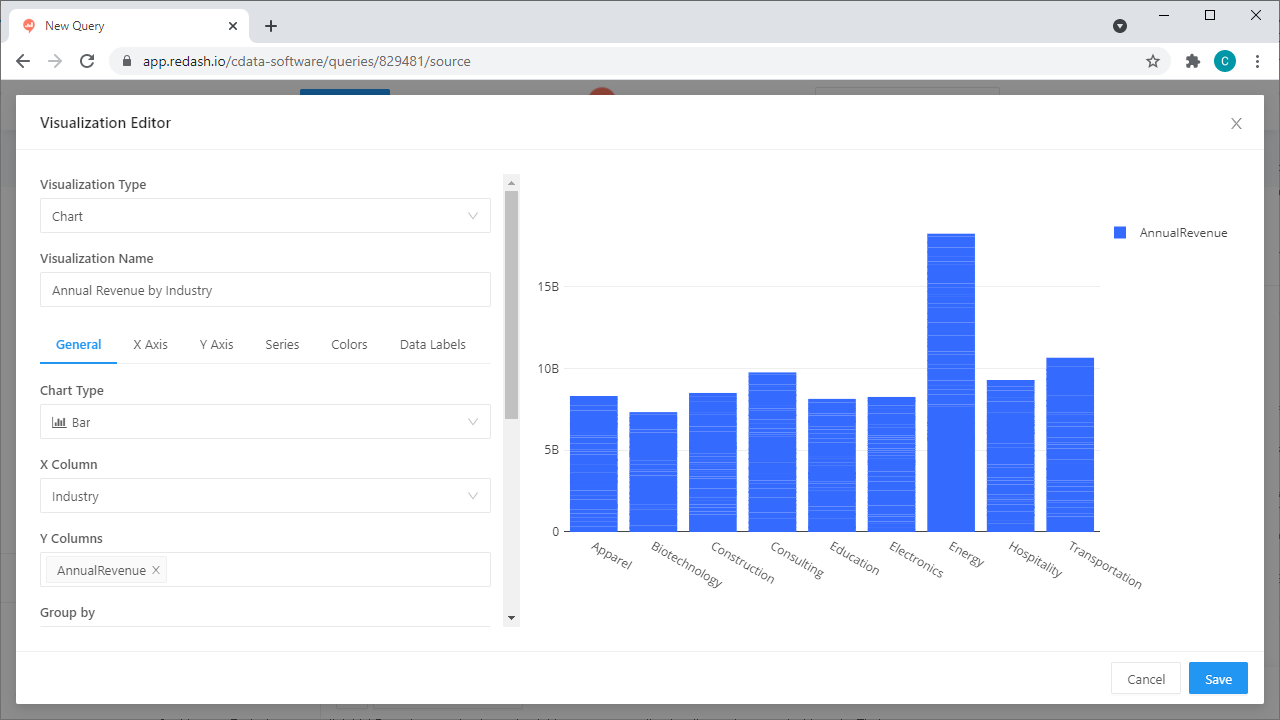Discover how a bimodal integration strategy can address the major data management challenges facing your organization today.
Get the Report →Build Amazon Athena-Connected Dashboards in Redash
Use CData Connect Server to create a virtual SQL Server Database for Amazon Athena data and build visualizations and dashbaords from Amazon Athena data in Redash.
Redash lets you connect and query your data sources, build dashboards to visualize data and share them with your company. When paired with CData Connect Server, you get instant, cloud-to-cloud access to Amazon Athena data for visualizations, dashboards, and more. This article shows how to create a virtual database for Amazon Athena and build visualizations from Amazon Athena data in Redash.
CData Connect Server provides a pure SQL Server interface for Amazon Athena, allowing you to easily build reports from live Amazon Athena data in Redash — without replicating the data to a natively supported database. As you build visualizations, Redash generates SQL queries to gather data. Using optimized data processing out of the box, CData Connect Server pushes all supported SQL operations (filters, JOINs, etc) directly to Amazon Athena, leveraging server-side processing to quickly return the requested Amazon Athena data.
Create a Virtual SQL Server Database for Amazon Athena Data
CData Connect Server uses a straightforward, point-and-click interface to connect to data sources and generate APIs.
-
Login to Connect Server and click Connections.
![Adding a connection]()
- Select "Amazon Athena" from Available Data Sources.
-
Enter the necessary authentication properties to connect to Amazon Athena.
Authenticating to Amazon Athena
To authorize Amazon Athena requests, provide the credentials for an administrator account or for an IAM user with custom permissions: Set AccessKey to the access key Id. Set SecretKey to the secret access key.
Note: Though you can connect as the AWS account administrator, it is recommended to use IAM user credentials to access AWS services.
Obtaining the Access Key
To obtain the credentials for an IAM user, follow the steps below:
- Sign into the IAM console.
- In the navigation pane, select Users.
- To create or manage the access keys for a user, select the user and then select the Security Credentials tab.
To obtain the credentials for your AWS root account, follow the steps below:
- Sign into the AWS Management console with the credentials for your root account.
- Select your account name or number and select My Security Credentials in the menu that is displayed.
- Click Continue to Security Credentials and expand the Access Keys section to manage or create root account access keys.
Authenticating from an EC2 Instance
If you are using the CData Data Provider for Amazon Athena 2018 from an EC2 Instance and have an IAM Role assigned to the instance, you can use the IAM Role to authenticate. To do so, set UseEC2Roles to true and leave AccessKey and SecretKey empty. The CData Data Provider for Amazon Athena 2018 will automatically obtain your IAM Role credentials and authenticate with them.
Authenticating as an AWS Role
In many situations it may be preferable to use an IAM role for authentication instead of the direct security credentials of an AWS root user. An AWS role may be used instead by specifying the RoleARN. This will cause the CData Data Provider for Amazon Athena 2018 to attempt to retrieve credentials for the specified role. If you are connecting to AWS (instead of already being connected such as on an EC2 instance), you must additionally specify the AccessKey and SecretKey of an IAM user to assume the role for. Roles may not be used when specifying the AccessKey and SecretKey of an AWS root user.
Authenticating with MFA
For users and roles that require Multi-factor Authentication, specify the MFASerialNumber and MFAToken connection properties. This will cause the CData Data Provider for Amazon Athena 2018 to submit the MFA credentials in a request to retrieve temporary authentication credentials. Note that the duration of the temporary credentials may be controlled via the TemporaryTokenDuration (default 3600 seconds).
Connecting to Amazon Athena
In addition to the AccessKey and SecretKey properties, specify Database, S3StagingDirectory and Region. Set Region to the region where your Amazon Athena data is hosted. Set S3StagingDirectory to a folder in S3 where you would like to store the results of queries.
If Database is not set in the connection, the data provider connects to the default database set in Amazon Athena.
![Configuring a connection (SQL Server is shown).]()
- Click Save Changes
- Click Privileges -> Add and add the new user (or an existing user) with the appropriate permissions.
With the virtual database created, you are ready to connect to Amazon Athena data from Redash.
Visualize Amazon Athena Data in Redash
The steps below outline creating a new data source in Redash based on the virtual Amazon Athena database in Connect Server and building a simple visualization from the data.
Create a New Data Source
- Log into Redash, click on your profile and click "Data Sources"
- Click the " New Data Source" button
- Select "Microsoft SQL Server" as the Data Source Type
![Creating a new Data Source.]()
- On the configuration tab, set the following properties:
- Name: Name the data source (e.g. Amazon Athena (CData Connect))
- Host: The full URL to your CData Connect instance (e.g. https://connect_server_url)
- Port: The port of the CData Connect SQL Server endpoint (e.g. 1433)
- User: A CData Connect user
- Password: The password for the above user
- Database name: The name of the virtual database for Amazon Athena (e.g. AmazonAthena1)
- Click the checkbox to Use SSQL
![Configuring the new Data Source.]()
- Click Create
- Click the "Test Connection" button to ensure you have configured the connection properly
With the new Data Source created, we are ready to visualize our Amazon Athena data.
Create a Amazon Athena Data Visualization
- Click Create -> New Query
- Select the newly created Data Source (you can explore the data structure in the New Query wizard)
- Write a SQL statement to retrieve the data, for example:
SELECT Name, TotalDue FROM Customers - Click the "Execute" button to load Amazon Athena data into Redash via CData Connect
![Loading Amazon Athena data into Redash]()
- Use the Visualization Editor to create and analyze graphs from Amazon Athena data
![Choosing a Database and Tables]()
- You can schedule the query to refresh and update the visualization periodically
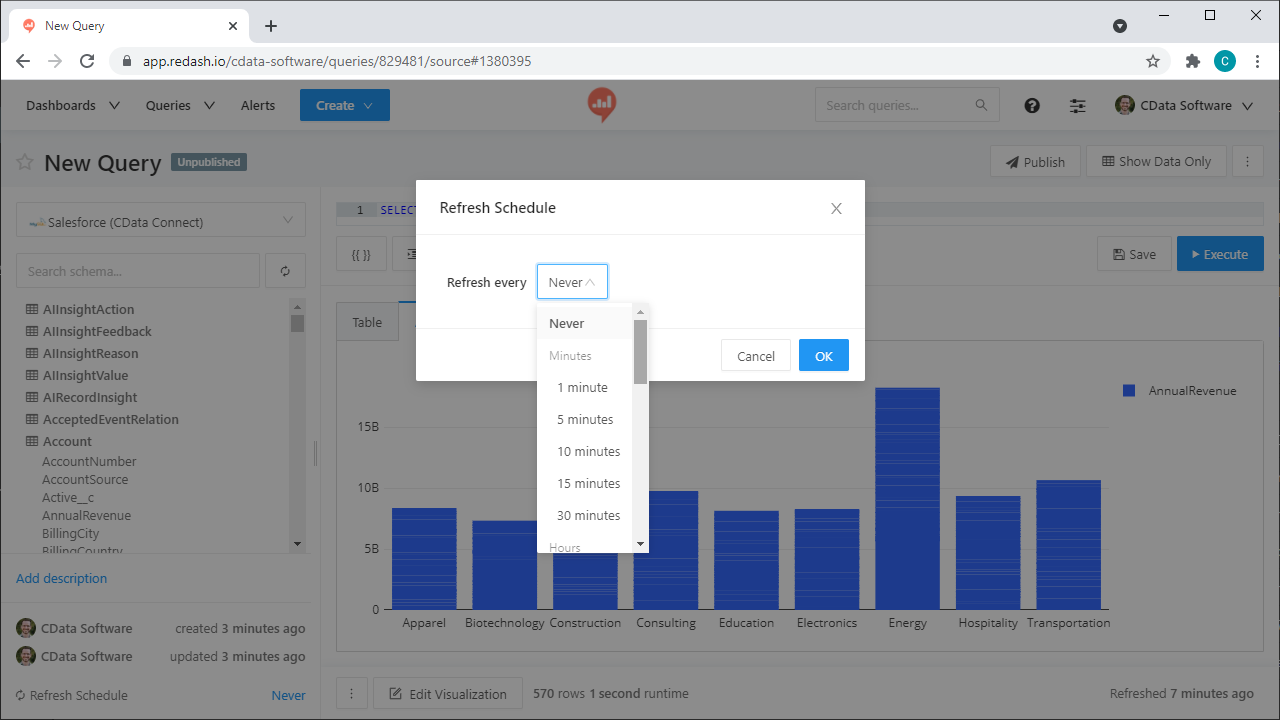
SQL Access to Amazon Athena Data from Cloud Applications
At this point, you have a direct, cloud-to-cloud connection to Amazon Athena data from Redash. You can create new visualizations, build dashboards, and more. For more information on gaining SQL access to data from more than 100 SaaS, Big Data, and NoSQL sources from cloud applications like Redash, refer to our Connect Server page.








